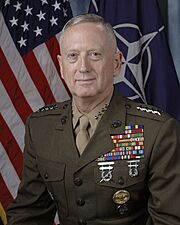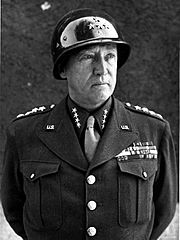Bronze Star Medal facts for kids
Quick facts for kids Bronze Star Medal |
|
|---|---|
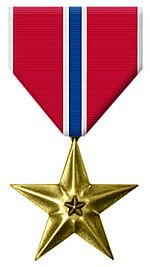
Front view
|
|
| Type | Military medal (Decoration) |
| Awarded for | "Heroic or meritorious achievement or service" |
| Status | Currently awarded |
| Clasps |
Army, Air Force, and Space Force – "V" device
|
| Statistics | |
| Established | Executive Order 9419, 4 February 1944 (superseded by E.O. 11046, 24 August 1962) |
| Precedence | |
| Next (higher) | Army: Soldier's Medal Naval Service: Navy and Marine Corps Medal Air and Space Forces: Airman's Medal Coast Guard: Coast Guard Medal |
| Next (lower) | Purple Heart |
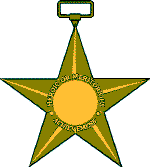 Medal ribbon (above) – Reverse side of star (below) |
|
The Bronze Star Medal (BSM) is a United States Armed Forces decoration awarded to members of the United States Armed Forces for either heroic achievement, heroic service, meritorious achievement, or meritorious service in a combat zone.
When the medal is awarded by the Army, Air Force, or Space Force for acts of valor in combat, the "V" device is authorized for wear on the medal. When the medal is awarded by the Navy, Marine Corps, or Coast Guard for acts of valor or meritorious service in combat, the Combat "V" is authorized for wear on the medal.
Officers from the other Uniformed Services of the United States are eligible to receive this award, as are foreign soldiers who have served with or alongside a service branch of the United States Armed Forces.
Civilians serving with U.S. military forces in combat are also eligible for the award. For example, UPI reporter Joe Galloway was awarded the Bronze Star with "V" device for actions during the Vietnam War, specifically rescuing a badly wounded soldier under fire in the Battle of Ia Drang Valley, in 1965. Another civilian recipient was writer Ernest Hemingway.
General information
The Bronze Star Medal was established by Executive Order 9419, 4 February 1944 (superseded by Executive Order 11046, 24 August 1962, as amended by Executive Order 13286, 28 February 2003).
The Bronze Star Medal may be awarded by the Secretary of a military department or the Secretary of Homeland Security with regard to the Coast Guard when not operating as a service in the Department of the Navy, or by such military commanders, or other appropriate officers as the Secretary concerned may designate, to any person who, while serving in any capacity in or with the Army, Navy, Marine Corps, Air Force, Space Force, or Coast Guard of the United States, after 6 December 1941, distinguishes, or has distinguished, herself or himself by heroic or meritorious achievement or service, not involving participation in aerial flight—
- (a) while engaged in an action against an enemy of the United States;
- (b) while engaged in military operations involving conflict with an opposing foreign force; or
- (c) while serving with friendly foreign forces engaged in an armed conflict against an opposing armed force in which the United States is not a belligerent party.
The acts of heroism are of a lesser degree than required for the award of the Silver Star. The acts of merit or acts of valor must be less than that required for the Legion of Merit but must nevertheless have been meritorious and accomplished with distinction.
The Bronze Star Medal (without the "V" device) may be awarded to each member of the Armed Forces of the United States who, after 6 December 1941, was cited in orders or awarded a certificate for exemplary conduct in ground combat against an armed enemy between 7 December 1941 and 2 September 1945. For this purpose, the US Army's Combat Infantryman Badge or Combat Medical Badge award is considered as a citation in orders. Documents executed since 4 August 1944 in connection with recommendations for the award of decorations of higher degree than the Bronze Star Medal cannot be used as the basis for an award under this paragraph.
Most Filipino and American servicemembers who served in the United States Army Forces in the Far East from 6 December 1941 to 10 May 1942 qualify to be awarded the Bronze Star Medal. They must have served on Luzon, Bataan, or Corregidor at any point within that five-month period in order to qualify.
Effective 11 September 2001, the Meritorious Service Medal may also be bestowed in lieu of the Bronze Star Medal (without Combat "V" device) for meritorious achievement in a designated combat theater.
Appearance
The Bronze Star Medal was designed by Rudolf Freund (1878–1960) of the jewelry firm Bailey, Banks & Biddle. (Freund also designed the Silver Star.)
The medal is a bronze star 1+1⁄2 inches (38 mm) in circumscribing diameter. In the center is a 3⁄16 inch (4.8 mm) diameter superimposed bronze star, the center line of all rays of both stars coinciding. The reverse bears the inscription "HEROIC OR MERITORIOUS ACHIEVEMENT" with a space for the name of the recipient to be engraved. The star hangs from its ribbon by a rectangular metal loop with rounded corners. The suspension ribbon is 1+3⁄8 inches (35 mm) wide and consists of the following stripes: 1⁄32 inch (0.79 mm) white 67101; 9⁄16 inch (14 mm) scarlet 67111; 1⁄32 inch (0.79 mm) white; center stripe 1⁄8 inch (3.2 mm) ultramarine blue 67118; 1⁄32 inch (0.79 mm) white; 9⁄16 inch (14 mm) scarlet; and 1⁄32 inch (0.79 mm) white.
Authorized devices
The Bronze Star Medal with the "V" device to denote heroism is the fourth highest military decoration for valor. Although a service member may be cited for heroism in combat and be awarded more than one Bronze Star authorizing the "V" device, only one "V" may be worn on each suspension and service ribbon of the medal. The following ribbon devices must be specifically authorized in the award citation in order to be worn on the Bronze Star Medal, the criteria for and wear of the devices vary between the services:
- Oak leaf cluster – In the Army, Air Force, and Space Force, the oak leaf cluster is worn to denote additional awards.
- 5/16 inch star – In the Navy, Marine Corps, and Coast Guard, the 5/16 inch star is worn to denote additional awards.
- "V" device – In the Army, the "V" is worn solely to denote "participation in acts of heroism involving conflict with an armed enemy."; in the Air Force and Space Force, the "V" is worn to denote heroism in combat.
- Combat "V" – In the Navy, Marine Corps, and Coast Guard, the "V" is worn to denote combat heroism or to recognize individuals who are "exposed to personal hazard during direct participation in combat operations".
History
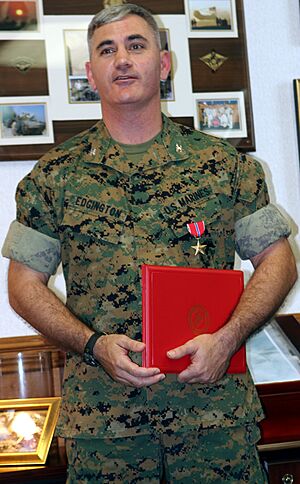
Colonel Russell P. "Red" Reeder conceived the idea of the Bronze Star Medal in 1943; he believed it would aid morale if captains of companies or of batteries could award a medal to deserving people serving under them. Reeder felt another medal was needed as a ground equivalent of the Air Medal, and suggested calling the proposed new award the "Ground Medal". The idea eventually rose through the military bureaucracy and gained supporters. General George C. Marshall, in a memorandum to President Franklin D. Roosevelt dated 3 February 1944, wrote
The fact that the ground troops, Infantry in particular, lead miserable lives of extreme discomfort and are the ones who must close in personal combat with the enemy, makes the maintenance of their morale of great importance. The award of the Air Medal has had an adverse reaction on the ground troops, particularly the Infantry Riflemen who are now suffering the heaviest losses, air or ground, in the Army, and enduring the greatest hardships.
The Air Medal had been adopted two years earlier to raise airmen's morale. President Roosevelt authorized the Bronze Star Medal by Executive Order 9419 dated 4 February 1944, retroactive to 7 December 1941. This authorization was announced in War Department Bulletin No. 3, dated 10 February 1944.
President John F. Kennedy amended Executive Order 9419 per Executive Order 11046 dated 24 August 1962 to expand the authorization to include those serving with friendly forces. This allowed for awards where US service members become involved in an armed conflict where the United States was not a belligerent. At the time of the Executive Order, for example, the US was not a belligerent in Vietnam, so US advisers serving with the Republic of Vietnam Armed Forces would not have been eligible for the award.
Since the award criteria state that the Bronze Star Medal may be awarded to "any person ... while serving in any capacity in or with" the US Armed Forces, awards to members of foreign armed services serving with the United States are permitted. Thus, a number of Allied soldiers received the Bronze Star Medal in World War II, as well as UN soldiers in the Korean War, Vietnamese and allied forces in the Vietnam War, and coalition forces in recent military operations such as the Persian Gulf War, War in Afghanistan, and the Iraq War. A number of Bronze Star Medals with the "V" device were awarded to veterans of the Battle of Mogadishu.
World War II infantry award
As a result of a study conducted in 1947, a policy was implemented that authorized the retroactive award of the Bronze Star Medal (without the "V" device) to all soldiers who had received the Combat Infantryman Badge or the Combat Medical Badge during World War II. The basis for this decision was that these badges were awarded only to soldiers who had borne the hardships which resulted in General Marshall's support of the establishment of the Bronze Star Medal. Both badges required a recommendation by the commander and a citation in orders.
Notable recipients
- Joe Medicine Crow, Crow War Chief and historian
- Julius Ochs Adler, publisher and journalist
- Eddie Albert, actor
- James Arness, actor
- Robert H. Barrow, 27th Commandant of the Marine Corps
- Eben Bartlett, member of the New Hampshire House of Representatives
- Tony Bennett, singer
- Rocky Bleier, NFL football player
- Rudy Boesch, contestant on Survivor: Borneo and Survivor All Stars
- Bill Bowerman, Coach; Co-founder of Nike, Inc. 4 Bronze Stars received
- Omar Bradley, US Army Chief of Staff and Chairman of the Joint Chiefs of Staff
- Edward Brooke, US Senator
- Russell Adam Burnham, U.S. Army Soldier of the Year in 2003
- Hugh Carey, Governor of New York State
- Leonard F. Chapman Jr., 24th Commandant of the Marine Corps
- Joseph S. Clark Jr., Mayor of Philadelphia, Pennsylvania
- Cordelia E. Cook, first woman recipient of the Bronze Star Medal and the Purple Heart
- Erastus Corning 2nd, Mayor of Albany, New York
- Tom Cotton, US Senator
- Alan "Ace" Cozzalio, US Army helicopter pilot
- Dan Crenshaw, Former United States Navy SEAL officer serving as the United States representative for Texas's 2nd congressional district since 2019.
- Robert E. Cushman Jr., 25th Commandant of the Marine Corps
- Dieter Dengler, aviator and escaper
- Ron DeSantis, Governor of Florida
- Bob Dole, US Senator
- Dale Dye, actor
- Frank Sutton, actor
- George Kennedy, actor
- Jeremiah Denton, US Senator
- Donnie Dunagan, actor
- Mark Esper, 27th US Secretary of Defense
- Walter Fetterly, Colonel who led a rescue mission deep in enemy territory
- Kenneth Raymond Fleenor, Mayor of Selma, Texas
- Henry Fonda, actor
- Joseph L. Galloway, war correspondent
- Maurice R. Greenberg, CEO of American International Group (AIG)
- Eric Greitens, Governor of Missouri
- Bob Gunton, actor
- Michael Hagee, 33rd Commandant of the Marine Corps
- Ernest Hemingway, writer and war correspondent
- Gil Hodges, Hall of Fame baseball player and manager
- Leo Hoegh, former Governor of Iowa
- Daniel Inouye, US Senator
- Bernard Jackvony, Lieutenant Governor of Rhode Island
- James L. Jones, 32nd Commandant of the Marine Corps, 22nd US National Security Advisor
- Bob Kalsu, NFL football player
- Otto Kerner Jr., Governor of Illinois
- Bob Kerrey, US Senator
- John Kerry, 68th US Secretary of State, senator of Massachusetts
- Ben Key, Royal Navy Admiral
- Henry Kissinger, Secretary of State and foreign affairs consultant
- Kareem Rashad Sultan Khan, Muslim-American soldier
- Charles C. Krulak, 31st Commandant of the Marine Corps
- Sharon Ann Lane, Army Nurse Corps
- Eddie LeBaron, NFL football player
- Dallas S. Linscheid, Captain, U.S. Army - 101st Airborne, 3x recipient, 2 tours in Vietnam,
- Douglas MacArthur, US General of the Army and Field Marshal of the Philippines
- Jim Mattis, 26th US Secretary of Defense
- John McCain, US Senator
- Ed Meads, NFL player
- Charles Mergendahl, novelist, television writer
- Glenn Miller, jazz musician and band leader
- John U. Monro, Dean of Harvard College
- Bud Moore, NASCAR team owner and crew chief, two Bronze Stars received
- Hal Moore, US Army Lieutenant General
- Robert Neller, 37th Commandant of the Marine Corps
- Scott O'Grady, Lieutenant most known for having the 2001 film Behind Enemy Lines (2001 film) based on his events in the Bosinan War
- Peter Pace, 16th Chairman of the Joint Chiefs of Staff
- Ferruccio Parri, leader of the Italian resistance movement
- George S. Patton, legendary general
- David Petraeus, Director of the CIA
- Colin Powell, 65th US Secretary of State, 12th Chairman of the Joint Chiefs of Staff
- Geronimo Pratt, high-ranking member of the Black Panther Party, two Bronze Stars received
- Lewis B. Puller, legendary US Marine Corps general
- Tony Radakin, 24th Chief of the Defence Staff
- Elliot Richardson, 11th US Secretary of Defense, 69th Attorney General, and Secretary of Commerce
- Tom Ridge, Governor of Pennsylvania, Secretary US Department of Homeland Security
- Mickey Rooney, actor
- Justus Rosenberg, member of the French Resistance, Commandeur de la Légion d'honneur, and Emeritus Professor of Languages and Literature
- Jack Rudin, real estate developer
- Rod Serling, writer/creator of The Twilight Zone
- Raymond P. Shafer, Governor of Pennsylvania
- Lloyd Stowell Shapley
- Larry Siegel, writer
- EJ Snyder, survivalist and television personality
- Oliver Stone, director
- Grace Thorpe, environmentalist and Native rights activist
- Pat Tillman, NFL player and US Army Ranger
- Lee Van Cleef, actor
- John Paul Vann, soldier and state department official
- Richard Vinroot, Mayor of Charlotte, North Carolina
- John Walsh, US Senator
- Edward Warburg, philanthropist
- Leroy H. Watson, Mayor of Beverly Hills, California
- Douglas Wilder, Governor of Virginia
- Elmo Zumwalt, 19th Chief of Naval Operations
- Desmond Doss, Combat Medic in Battle of Okinawa
- Robert M. Filbert III, Philosopher and MS LEO
See also
 In Spanish: Estrella de Bronce para niños
In Spanish: Estrella de Bronce para niños



